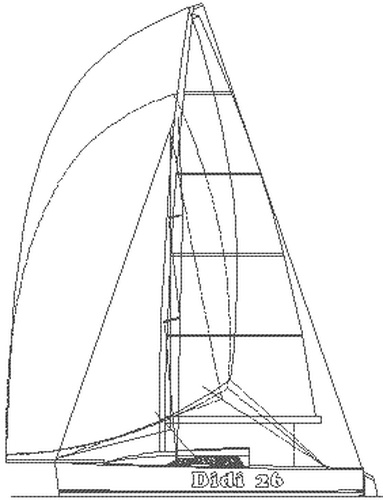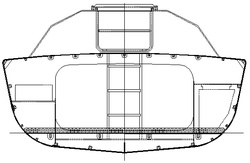Didi 26 by Dudley Dix
Radius chine plywood trailer-sailer
| Length overall | ||
|---|---|---|
| Waterline length | ||
| Beam | ||
| Draft | ||
| Draft (cb up) | ||
| Berths | 4 | |
| Headroom | ||
| Weight | ||
| Ballast weight | ||
| Displacement | ||
| Sail area | ||
| Main area | ||
| Jib area | ||
| Genoa area | ||
| Engine power | 10 | |
| Hull construction | Plywood radius chine | |
| See also | Didi 23, Didi 28, Didi 29 Retro | |
| compare | ||
URL: http://www.dixdesign.com/26didi.htm
Description:
Affordable performance
- Economy of plywood
- Radius chine hull, stitch & glue cabintop
- Round bilge from sheet material
- Within abilities of amateur builders
- Easily handled fractional rig
- Two rig options
- Lifting or fixed keel options
- High performance racing for Dad
- Comfortable weekending for the family
- Too big for you? See the Didi 23
A high performance trailer sailer which you can build for yourself from plans, this design was drawn as a little sister to the DIDI 38 which I designed and built for myself in 1994/95, and the more recent DIDI 34, Didi MG30 and the Didi Mini, to the Mini 6.5 rule. Most recent addition to this range is the Didi 23
Simple Plywood Construction
It employs the same basic radius chine plywood construction technique, scaled down to suit the smaller boat but takes it a step further into the plywood precut kit concept. The small size of the vessel permits the elimination of the laminated floors needed to support the keel loads in the larger boats. Keel loads are, instead, carried by bulkheads and the structure of the keel box. All of these parts are plywood and epoxy filleted together, making for simplified construction.
The backbone is also of plywood, on edge, slotted through the bulkheads as a self-jigging eggcrate arrangement to assist setting up the framework. It extends from the stemhead to the transom and has large radius structural fillets to tie it into the hull skin.
Assembly of the hull follows the principles of model aeroplane construction, with stringers slotted into the bulkheads for attachment of the skin. The hull skin is single skin plywood to the sides and bottom and the radius is done in two layers.
Deck construction is done in a similar way, all in single skin plywood. The cabintop is designed with a multi-chine skin and is assembled over the bulkheads by the stitch and glue method for a strong and lightweight structure.
Suggested plywood for construction is Israeli Gaboon ply throughout. Epoxy coated and painted inside and out to hull and deck, a good standard of finish is achievable with little or no fairing aside from forming fillets at internal angles. The addition of a layer of glass fabric to the outside will give increased resistance to knocks but will add weight and require fairing, thereby adding a fair amount to construction time and cost.
Two Keel Options
The standard keel is a vertical dropkeel with a 400kg bulb on the end of the high aspect foil. It is lifted by a tackle system led to a cabintop winch. Fully retracted, the bulb remains below the hull, with a draft of 0,5m. Sailing draft is 1.7m. The bulb can be done in either a simple vertical sided foil section for owner casting or a torpedo shape for professional casting. The rudder has a fixed blade and is transom hung on conventional pintles.
We have now added a fixed keel option as well. This uses a hollow aluminum casing for the foil, constructed over tubular inner framing and fitted with the same bulb options as the lifting keel. The casing is bolted through the hull bottom to an aluminum support box, which is bolted to the internal structure of the hull.
The cockpit and bridgedeck together are 3m long, giving plenty of space for working the boat while racing or socialising or sunning when cruising. The only winches on the boat are a pair of 16:1 self-tailers on the cabintop. They are located where they can be operated from the companionway, the bridgedeck or the weather rail. They are oversized to ease keel handling so sail trimming will be a cinch.
Easily Handled Rig
The rig is deck stepped on a hinged foot, fractional with two sets of swept spreaders. This makes her easy to handle with a small crew whether racing or cruising. Shrouds go to outboard chainplates to minimise rig loadings. The working headsails are non-overlapping and sheet inside the shrouds. A light drifter can be flown outside the shrouds and sheets to the spinnaker blocks on the quarters.
The fractional and masthead spinnakers are asymmetric, set on a retractable pole on the foredeck. The inboard end is fitted on a radiused transverse track to allow the outboard end to be projected up to weather for sailing at deeper angles. Extension and retraction of the pole can be done from either rail, with the pole retracting to whichever side is convenient at the time.
Cruising Rig Option
- Detuned rig for cruising or stronger wind areas
- Fully inter-changeable with tall rig
- Mainsail excl roach = 17.55sq.m (189sq.ft)
- Sail Area Main + Jib = 29.01sq.m (312sq.ft)
- P = 9.00m (29'6")
Weekending or racing accommodation
Down below she has sitting headroom throughout. She has a small galley with two-plate cooker, sink, icebox and a seat for the cook. The dropkeel casing forms one side of the enclosed heads compartment, which includes a bin type wet locker. The dinette table drops to convert the pair of single V-berths into a double. The prime berth in the boat is a large transverse double under the bridgedeck, great for use on moorings or at anchor. Aft is loads of storage space accessible from the berth.
Alternatives on the basic design are already available. A longer cockpit has been drawn, more suitable for the gofast racer. Down below it goes along with a pair of quarter berths, also more suited to the hairy chested racer and use under sail. Both layouts are included in the stock plan package.
Auxiliary power is provided by an outboard clamped to the transom or saildrive inboard.
As shown here, she is in cruiser/racer configuration, with lightship displacement of approximately 1000kg and cruising displacement of 1500kg. In stripped racing configuration, she will be about 200kg lighter. Although not designed to their limits, she was drawn to fit within the class rules of the now defuct Australian Level Class 800 Association, a set of rules that was formulated to give boat-for-boat racing for trailer sailers.
Full Size Patterns
Included in the stock plan package are full size patterns of the backbone and various other components, plotted onto mylar film on our large format inkjet roll plotter. Bulkhead shapes are simple and easily set out from clear diagrams, the setting out taking about 2 to 3 hours per bulkhead. For those who would prefer to have full size patterns for the bulkheads, we can also supply them as an optional extra. Choose the building option to suit your own needs. Whichever route you choose, we will be available to assist with advice if any problems arise.
See also
Boats about same size as Didi 26
|
Deception Bay Sharpie 26 CK
26 ft Trailer Sharpie - Modern design
|
|
|
Vagabond 26
[VG26] An offshore capable cruising boat with shallow draft
|
Questions? Suggestions? Contact us at: info@boatplans.cc



